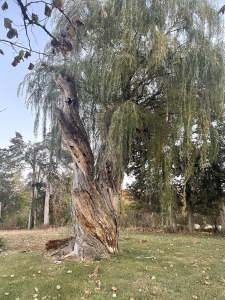
On a recent trip to see my family in Iowa, I felt the need to visit a local cemetery. I was not visiting any specific gravesite. Although there was a solemn feel to the visit, I was there to take in a rare ecological community.
Rochester cemetery is a remnant of a prairie oak savanna. Before this area was settled and plowed into farmland, it was a unique area between the grasslands of the west and the forests of the east. Fire kept most trees from establishing in the prairie. In prairie savannas, occasional white oaks and bur oaks resisted the fires and spread their branches out over the grasslands.

There are few remnants of tall grass prairie left. There are even fewer tall grass savannas. Due to a “limited maintenance” plan of occasional mowing and burning, Rochester Cemetery has a diverse plant community with over 350 plant species. But what stands out are the ancient spreading oak trees.

If you want to see magnificent trees, take some time to wander through old cemeteries. There, trees have a chance to spread their branches. They do not have as many issues with soil compaction, are not impacted by trenching for underground utilities, are not heavily pruned for wires, and do not deal with issues that trees in our yards and parks face. Sometimes the trees are well-maintained, other times they thrive on being neglected and forgotten.

An old willow tree like this would probably not remain in somebody’s well-kept yard. At the edge of a small rural cemetery, it continues to both grow and die.

This post oak stands alone on a hill in Maury Cemetery. Half of this tree split off about 15 years ago, leaving a large open wound on the trunk. In other settings, this tree would likely have been removed for fear of the rest of the tree failing. Instead, here, the tree has remained standing.

A black gum towers in Hollywood Cemetery, which is also an accredited arboretum. Hollywood was designed as a park cemetery to provide a green space for people to visit outside of the city.

There is an ancient association with yew trees and cemeteries . Yews can live for centuries. Most of the plant is toxic to humans. The association between long life and death are probably why yews are linked with cemeteries.
Next time you are traveling by an old cemetery with a little time on your hands, slow down, turn in, and explore. Be respectful. These are places of reverence and reflection. They can also be home to amazing trees.


